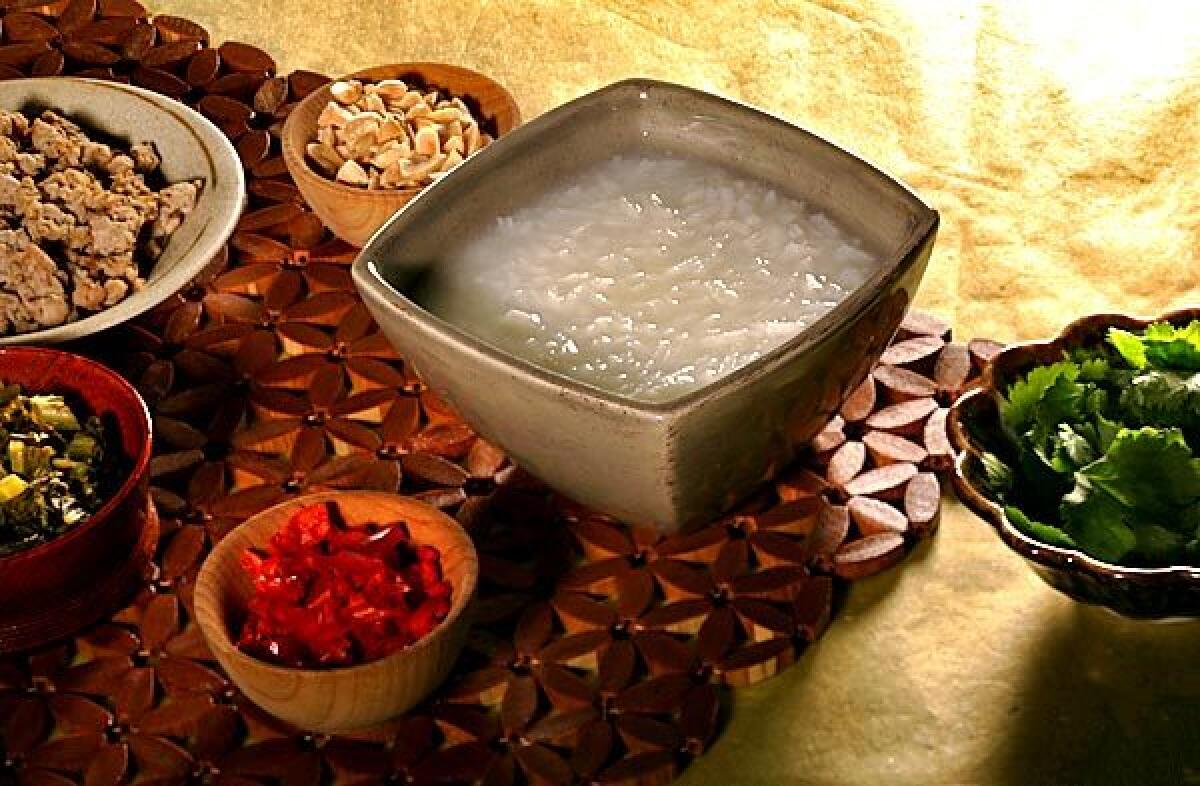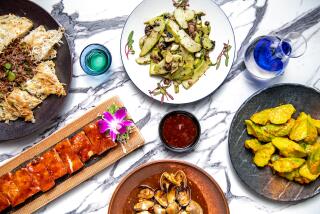Cooking up a craving for congee

- Share via
When I was in college and for years after, whenever I went into San Francisco to catch a late set of jazz, the evening always ended in Chinatown with a bowl of congee. I can’t think of anything more restorative that late at night. Or any other time, really.
Congee, for the uninitiated, is basically rice boiled with water until it has a porridge-like consistency. I know, it sounds pretty boring. But don’t stop reading yet. The genius is in the garnishes — which can be seafood, sausage, pork, duck, thousand-year-old egg and a kazillion other tidbits. Before digging in with a Chinese soup spoon, you dose your congee (known as jook in Cantonese) with chile paste, soy sauce, cilantro and peanuts.
I’m crazy for dishes in which every bite is slightly different, which is to say, don’t mix up your congee to make a homogenous mass. Those Chinatown congee were mostly seafood, brilliant because the cook adds the bits of squid, fish, shrimp to each bowl just before serving. The rice is so hot it cooks them right in the bowl, and as a result each element has a pure, bright flavor.
When I went to Hong Kong for the first time, I couldn’t wait to try the congee there. My big pleasure was to get up early every morning and try a new hole-in-the-wall. Afterward, I’d walk and walk all over the city, exploring different neighborhoods until I’d worked up enough appetite for dim sum.
These days I’m not going to drive to Monterey Park every day for a congee fix, so I’ve started making it at home. Not every day, but often, sometimes for breakfast, sometimes for an early lunch.
It’s laughably easy to make at home. Basically, it involves boiling one cup of rice to eight cups of water. (Use more if you like your porridge looser.) Remember to wash the rice well beforehand until there’s no floury residue. Some aficionados use brown rice or mixed whole grains. Find your preference. Some like the rice cooked until it’s broken down almost into a slurry. Others like to stop while the grains of rice are still intact. (That would be me.) Some like to build in a little flavor by cooking the rice with sliced fresh ginger or a few dried shiitake mushrooms.
Making congee is a great way to use up leftovers too small for anything else. If you have a few slivers of pork, half a chicken breast, shredded duck confit, a little ragù, a couple of shrimp left over from some other meal, put them in a congee. When I went to check out the new McCall’s Meat & Fish in Los Feliz, I picked up a small piece of Kurobuta pork loin, just under half a pound, that was sitting in the case. Stir-fried, it would be enough to garnish congee for four.
Other ideas: add diced Smithfield ham, some dried shrimp or dried scallops, whatever you have on hand. Make tiny meatballs. You could make a vegetarian version with shiitake mushrooms, scallions, cabbage and other vegetables and maybe even some custardy thousand-year-old egg. Or you could go entirely seafood with squid, dried scallops, shrimp and chunks of fish. You could also make your congee an innards fest with pork liver and kidney in the mix.
Now comes the fun part: the garnishes. Set out a series of small bowls, each holding a different ingredient, so guests can garnish their congee at the table. These should include some sliced scallions, cilantro leaves, roasted (preferably unsalted) peanuts, maybe some Chinese pickled vegetables and sliced chiles or crimson chile paste. Pass the soy sauce too. Some people like a drizzle of sesame oil and a pinch of white pepper.
One of my indispensable garnishes is Hunanese chopped salted chiles, which I have to have on hand at all times. They’re incredibly easy to make — and pack an irresistible wallop of heat and salt. The recipe is from British food writer Fuschia Dunlop’s must-have “Revolutionary Chinese Cookbook.”
Rice gruel is a staple all over Asia, and while I love the traditional Chinese congee, another favorite version is chao za ga from Vietnam, perfumed with lemon grass and served with a squeeze of fresh lemon. In this version, jasmine rice is simmered in chicken stock with lemon grass, Thai chiles and a dash of fish sauce, so the porridge itself has more flavor than the neutral Cantonese style congee. It’s surprisingly light and delicate.
The beautiful thing is that if you’ve got a few condiments stashed in your refrigerator, you can always make congee for yourself — or a sudden crowd — when the mood strikes. And once you’ve developed a craving for this Asian comfort food, believe me, you’ll be making it often.
More to Read
Eat your way across L.A.
Get our weekly Tasting Notes newsletter for reviews, news and more.
You may occasionally receive promotional content from the Los Angeles Times.










